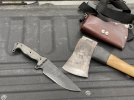- Joined
- Oct 4, 2015
- Messages
- 925
I put shaving-sharp edges on all my axes except for my splitting maul. That gets sharpened but just with a coarse file.
The edges on all my axes last for a good long while, except for my Fiskars hatchet which dulls fairly quick. My main axe, a woodcarving hatchet in S7, keeps a shaving edge for a long while.
The edges on all my axes last for a good long while, except for my Fiskars hatchet which dulls fairly quick. My main axe, a woodcarving hatchet in S7, keeps a shaving edge for a long while.


